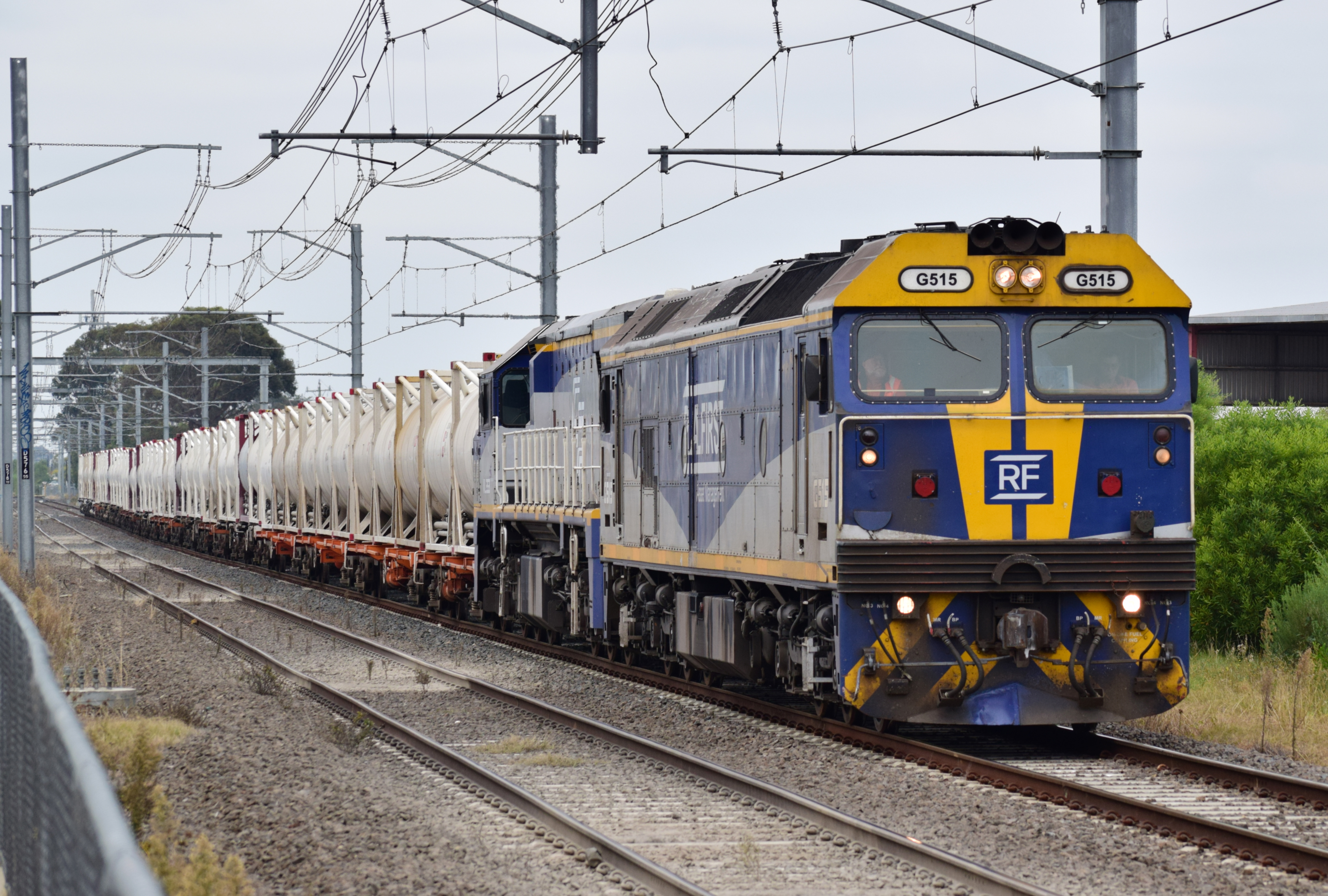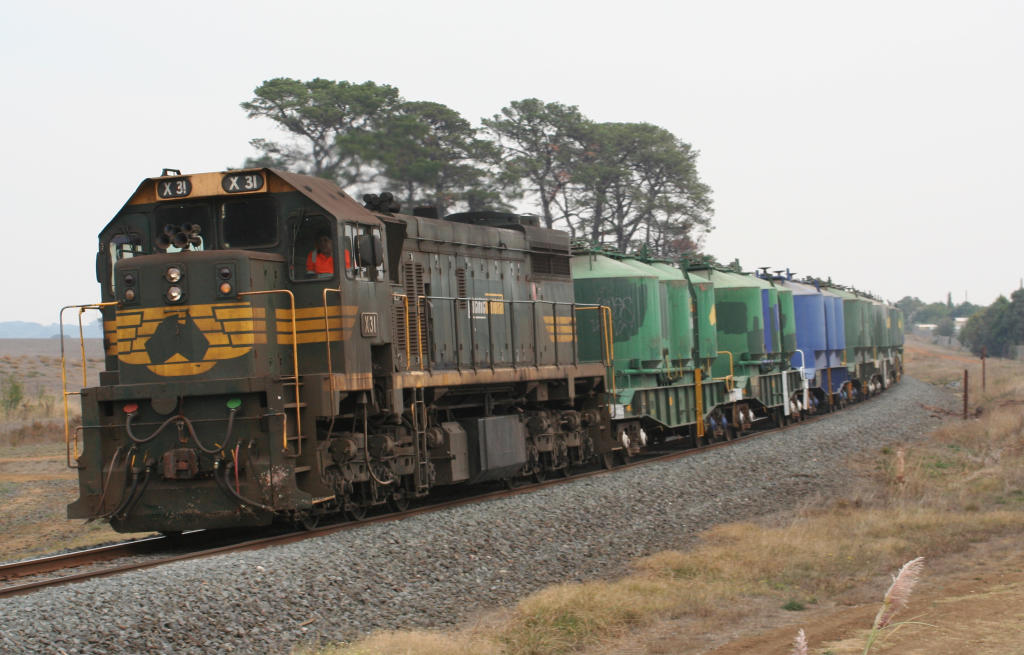|
SCT Logistics
SCT Logistics is an Australian interstate transport company operating rail and road haulage, with facilities in Brisbane, Sydney, Parkes, Melbourne, Adelaide and Perth. History SCT Logistics was founded in 1974 as Specialised Container Transport. In the mid-1990s, National Rail decided to discontinue the use of refrigerated vans, louvred vans, and boxcars on its trains. At the same time, Australia's rail network was being opened up to enable private operators the use of publicly owned railway track. SCT had a customer base who wished to retain their use, so a number of surplus covered wagons were acquired, and hook and pull agreements were agreed with V/Line Freight (Melbourne to Adelaide) and Australian National (Adelaide to Perth) to haul the trains. In July 1995, SCT began operating a weekly service from Melbourne to Perth. The initial terminals for the service were at Dynon in Melbourne, Keswick in Adelaide and Kewdale in Perth. These were later replaced by purpose ... [...More Info...] [...Related Items...] OR: [Wikipedia] [Google] [Baidu] |
Downer EDI Rail GT46C ACe
The GT46C ACe is a model of Australian diesel electric locomotive designed and built by Downer Rail at its Cardiff Locomotive Workshops using Electro-Motive Diesel components from 2007. The first units were built as the SCT class for freight operator SCT Logistics from 2007 followed by the LDP class and TT class for Pacific National, the GWA class and GWB class for Genesee and Wyoming Australia (later One Rail Australia which was sold to Aurizon in July 2022) the WH class for Whitehaven Coal, and the SSR class for Southern Shorthaul Railroad. Design The class was a new design for Australian conditions based on other locomotives produced by Downer EDI Rail, such as the narrow gauge GT42CU AC purchased by Queensland Rail and Pacific National and the GT46C purchased by Westrail, Freight Australia and FreightLink. The GT42CU AC used a 12-cylinder EMD 710 engine, based on the USA built SD70MAC with scaled down traction motors, while the GT46C used a 16-cylinder EMD 710 engine ... [...More Info...] [...Related Items...] OR: [Wikipedia] [Google] [Baidu] |
Australian National Railways Commission
The Australian National Railways Commission was an agency of the Government of Australia that was a railway operator between 1975 and 1998. It traded as Australian National Railways (ANR) in its early years, before being rebranded as Australian National. AN was widely used from 1980, the logo, logotype being registered as a trade mark. History Australian National Railways was established by the Whitlam Government, Whitlam Federal Government following a commitment made in the 1972 Australian federal election, 1972 election to invite the states to hand over their railway systems to the federal government. On 1 July 1975, Australian National Railways was formed taking over the operations of the federal government owned Commonwealth Railways. The state governments of Government of South Australia, South Australia and Government of Tasmania, Tasmania whose railway systems were deeply in debt, accepted. During the next two years, discussions between these two states and the federa ... [...More Info...] [...Related Items...] OR: [Wikipedia] [Google] [Baidu] |
NR Class
The NR class are a class of Australian diesel locomotive built by A Goninan & Co for National Rail between 1996 and 1998. They are currently operated by Pacific National. The C44aci model locomotives built by UGL Rail at Broadmeadow adopted the design from the NR Class. History When National Rail commenced operations in April 1993, it inherited a diverse collection of rolling stock and locomotives from various operators to operate interstate freight services in Australia. The fleet included locomotives of mixed age and power, leased from FreightCorp, V/Line and Australian National. In September 1995, National Rail awarded a contract to A Goninan & Co for 80 locomotives, which later became 120. NR1-NR60 were built at Broadmeadow, and NR61-NR120 were constructed at Bassendean."National Rail Loco Contract Signed" ''Railway Digest'' October 1995 page 6 The frames were built at Hexham and the bogies at Goninan's Landsdowne Engineering subsidiary in Taree. The first ... [...More Info...] [...Related Items...] OR: [Wikipedia] [Google] [Baidu] |
Australian Railway History
''Australian Railway History'' is a monthly magazine covering railway history in Australia, published by the New South Wales Division of the Australian Railway Historical Society on behalf of its state and territory Divisions. Australian Railway Historical Society History and profile It was first published in 1937 as the ''Australasian Railway and Locomotive Historical Society Bulletin'', being renamed ''ARHS Bulletin'' in 1952. In January 2004, the magazine was re-branded as ''Australian Railway History''. Historically, the magazine had a mix of articles dealing with historical material and items on current events drawn from its affiliate publications. Today, it contains only historical articles, two or three of them being in-depth.Parameters * Size : A4; ...[...More Info...] [...Related Items...] OR: [Wikipedia] [Google] [Baidu] |
Railway Digest
''Railway Digest'' is a monthly magazine, published in Sydney, covering contemporary railways of Australia. Overview The magazine's publisher is the Australian Railway Historical Society (ARHS), NSW Division. The first issue was published in March 1963 under the name ''New South Wales Digest'' and regular publication commenced with the May 1963 edition. It was renamed in January 1983. In January 1985 it changed paper size from SRA5 to A4. Originally an enthusiast magazine mainly focusing on reporting day-to-day workings of the New South Wales Government Railways and it successors, it was produced by volunteers using a hand-operated duplicator at the home of one of its members. In May 1993, a paid editor was appointed and the magazine's focus gradually shifted to reporting news from across Australia. It has evolved into a professional full-colour production directed at the wider community and commercially distributed to newsagents throughout Australia."Adapt or disappear - the ... [...More Info...] [...Related Items...] OR: [Wikipedia] [Google] [Baidu] |
Nullarbor Plain
The Nullarbor Plain ( ; Latin: feminine of , 'no', and , 'tree') is part of the area of flat, almost treeless, arid or semi-arid country of southern Australia, located on the Great Australian Bight coast with the Great Victoria Desert to its north. It is the world's largest single exposure of limestone bedrock, and occupies an area of about . At its widest point, it stretches about from east to west across the border between South Australia and Western Australia. History Historically, the Nullarbor was seasonally occupied by Indigenous Australian people, the Mirning clans and Yinyila people. Traditionally, the area was called ''Oondiri'', which is said to mean "the waterless". The first Europeans known to have sighted and mapped the Nullarbor coast were Captain François Thijssen and Councillor of the Indies, Pieter Nuyts, on the Dutch East Indiaman '''t Gulden Zeepaert'' (the Golden Seahorse). In 1626–1627, they charted a stretch of the southern Australian coast eas ... [...More Info...] [...Related Items...] OR: [Wikipedia] [Google] [Baidu] |
V/Line G Class
The G Class are a class of diesel locomotive built by Clyde Engineering, Rosewater and Somerton for V/Line between 1984 and 1989. History By the early 1980s, the first generation diesels purchased by the Victorian Railways were nearly 30 years old, with an average fleet age of 20 years. In addition, 70% of the fleet was of 1,000 horsepower or less, a consequence of the historically large number of branch lines in the state. Rationalisation of the rail freight task had also been carried out, with small freight consignments being consolidated to 'freight centres' from 1976. Moves had also been made towards the operation of block trains carrying a single commodity, rather than trains carrying a wider variety of freight. Grain became the major commodity carried by rail in Victoria, with the consulting arm of Canadian National commissioned by VicRail in 1983 to find ways of improving efficiency. Recommendations carried out included increasing train sizes to 50 bogie wagons and ... [...More Info...] [...Related Items...] OR: [Wikipedia] [Google] [Baidu] |
Freight Australia
Freight Australia was an Australian railway company that purchased the V/Line Freight business from the Government of Victoria in 1999. Initially known as Freight Victoria, it operated rail freight services and controlled non-urban rail track in the state of Victoria, later expanding into freight haulage in other states. Freight Australia was sold to Pacific National in August 2004. Background V/Line formerly had a freight division, known as V/Line Freight. Under the Kennett State Government, V/Line was split into two separate entities on 1 July 1997: V/Line Passenger and V/Line Freight, with separate management to each other in preparation for privatisation. When V/Line was privatised in 1999, the passenger and freight divisions were sold separately. History Inception The company was formed in March 1999 when the Freight Victoria consortium was announced by the Victorian State Government as the successful bidder for the state owned V/Line Freight business. [...More Info...] [...Related Items...] OR: [Wikipedia] [Google] [Baidu] |
Penfield, South Australia
Penfield is a northern suburb of Adelaide, South Australia, in the City of Playford. William Penfold, one of the first settlers in the area, subdivided land he had bought in the Hundred of Munno Para in 1856 to create the township of Penfield. The area was commonly known as Peachey Belt or Peachy Belt. The boundaries have changed over the years, the original township being overshadowed by the government acquisition of land immediately south of the early town centre since the 1940s for construction of military facilities such as the Penfield munitions factory. As a result, much of the modern peri-urban locality of Penfield is used for industrial purposes rather than residential and the original town centre is no longer a population centre. The remaining part of the Zoar Bible Christian Church, built in 1855, is the small cemetery. History Before European settlement, the Kaurna people inhabited the land. The district was surveyed in 1849, as part of the Hundred of Munno Para. Ear ... [...More Info...] [...Related Items...] OR: [Wikipedia] [Google] [Baidu] |
Laverton North
Laverton North is a suburb in Melbourne, Victoria, Australia, west of Melbourne's Central Business District, located within the City of Wyndham local government area. Laverton North recorded a population of 119 at the 2021 census. Located on the rural-urban fringe, Laverton North is bounded by Boundary Road to the north, Derrimut Road and the Federation Trail to the west, Old Geelong Road and the West Gate Freeway to the south and Kororoit Creek to the east. It is predominantly an industrial suburb An industrial suburb is a community, near a large city, with an industrial economy. These communities may be established as tax havens or as places where zoning promotes industry, or they may be industrial towns that become suburbs by urban spra .... Demographics In the 2011 census, 69.23% were born in Australia, 9.89% New Zealand, 4.4% Malta, 3.3% United Kingdom and 13.18% in other countries. 50.55% claimed Christianity, 30.77% claimed other or no religion, 3.3% Buddhism and ... [...More Info...] [...Related Items...] OR: [Wikipedia] [Google] [Baidu] |






